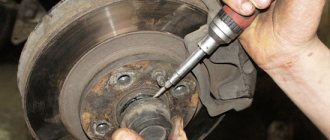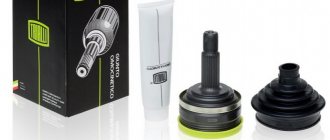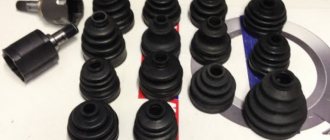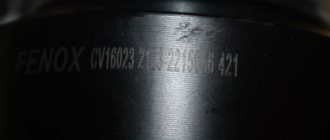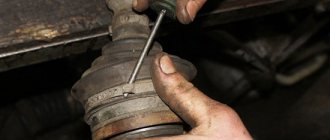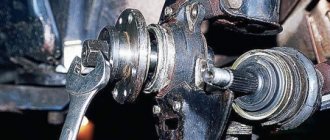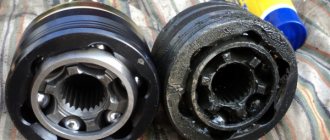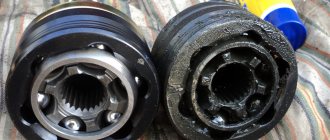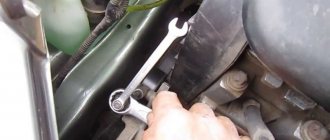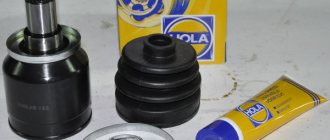Replacing outer and inner CV joints on Lada Kalina
CV joint (constant velocity joint - approx.) or popularly just a “grenade”, is designed to transmit torque to the wheels of a car. CV joints can be internal or external, and the devices themselves are quite simple in technical terms and consist of a ball bearing that rotates transversely to its axis.
In the video, replacing CV joints on a Lada Kalina:
Failure of the CV joint on the Lada Kalina is a very common occurrence, and the main reason for its failure is torn anthers. Because, together with dust and water falling under them, the lubricant turns into thick mud, and it is no longer able to fully perform its functions.
Replacing the outer CV joint
In the process of replacing the outer CV joint
The work of replacing an outer or inner CV joint is not very difficult and can be done by any motorist who has at least once repaired a car with his own hands. And in order for the repair to be easier and faster, you need to prepare the following tools:
- Socket heads for “17” and “30”.
- Driver or ratchet.
- Extension for the wrench.
- Jack.
- Wheel chocks.
- Hammer.
- Vise.
Step-by-step disassembly procedure
After you are convinced of the malfunction of one or another CV joint, you can begin to work.
- First of all, we tear off the mounting bolts from the wheel and the hub nut, then we set the wheel chocks under the rear wheels. (To make it easier to tear off the nuts, it is better to use an extension for the wrench - approx.).
- We put the car on a jack and hang the wheel.
- We remove the wheel and, for greater reliability, place it under the car next to the jack.
- Now that this picture appears before you, all that remains is to unscrew the 2 bolts that secure the ball joint to the steering knuckle.
Unscrew the bolts marked with a red marker on both sides.
CV joint VAZ. Lada grenade. Comparison of different manufacturers
They counterfeit everything related to the AvtoVAZ assembly line. Any part purchased at a car store can be a counterfeit...
BEWARE OF FAKE! CV joint LADA Image. features
CV Joint Review
(grenades) for VAZ 2108-2115.
Without causing strong blows, the CV joint will move out of place
If the internal CV joint is supposed to be replaced, then work 1 to 6 should be performed as well, after which, using a pry bar, we remove it from the gearbox and take out the entire assembly.
Assembly
The new boot is placed on the axle shaft. The places where the parts come into contact should first be well treated with lubricant. The grease must also be pressed into the grenade itself. Then:
- install the bearing on the axle shaft using a hammer and a wooden block;
- remove excess air from the boot and tighten the clamp;
- put on the steering knuckle;
- tighten the hub nut using a torque wrench.
Now all that remains is to tighten all the wheel nuts and lower the car from the jack.
With a new bearing you can safely drive 250-300 thousand kilometers. However, the condition of the boot can significantly reduce this distance. Due to the fact that dirt, sand and water get inside, the lubricant becomes like an abrasive, which slowly but surely destroys the bearing.
Now you know how to replace the boot on Kalina. This can easily be done by one person in one and a half to two hours using ordinary tools. But to guarantee quality repairs, we advise you to contact specialists.
Today we will look at how to replace the CV joint boot on a Lada Kalina, and also learn how to identify a problematic CV joint.
Signs of CV joint failure
The first signs of a faulty grenade are crunching sounds in the area of the front wheel on turned out wheels when starting to move. When the fault is severe, noise appears at less significant loads.
The anther begins to crawl
In order to prevent such damage in advance, you should periodically inspect the anthers from the outside for cracks and integrity in general.
Who has more choice of engines and gearboxes?
Starting from 2011, the models are almost identical in terms of power units. Both are equipped with 1.6 liter engines with capacities of 87, 98, 106 horsepower. The difference in the number of “horses” under the hood is achieved by modifying the engines and timing belt. But the Granta in the Sport package has a special 16-valve unit with 118 hp. With.
As for gearboxes, the brainchild of AvtoVAZ has two of them - 5 manual transmissions (modernized, cable) and 4 automatic transmissions from Jatco. True, in 2018, Granta also received a robotic 5th gearbox. And a little later, “Kalina 2” also inherited the “robot”.
On a note!
Constant velocity joints, which are sold in the store in sets, include grease, a boot and all the necessary clamps in their sets. Pay special attention to this fact so as not to overpay for additional spare parts and accessories.
I had to change more than one CV joint. Of course, I had to tinker with the first one for a couple of hours, since I didn’t really know all the subtleties, but I changed the subsequent ones almost with my eyes closed.
I bought a grenade for viburnum. The assembly includes the grenade itself, a finger guard and clamps. You can change it in an hour without rushing, it can be done faster. But why rush in such a matter?
"Lada Kalina" is a front-wheel drive car in which the engine and gearbox are located transversely relative to the body. The drive to the wheels is carried out through the main gear. Torque is transmitted through constant velocity joints (simply CV joints, or “grenade”). There are several of them - internal and external. Despite their reliability, these elements can fail. Well, let's look at how to replace a “grenade” on a Kalina, what tools are needed for this and what are the signs of a malfunction.
Grenade
The Kalina CV joint or “grenade,” as car owners call this unit in driver’s slang, is a mechanism that transmits rotation to the wheels. Structurally, grenades are quite simple, while ensuring rotation of wheels that are not located parallel. The functional unit is securely covered under a ribbed cover containing lubricant inside. After several years of hard work, the rubber boot of the hinge exhausts its service life: its surface becomes covered with tears, allowing lubricant to seep out, and dust and water begin to actively penetrate into the unit from the external environment. If the defect that has arisen is not detected in a timely manner, the Lada Kalina grenade can very quickly fail, since the mechanism does not tolerate moisture, sand and dirt falling on the contacting surfaces. Prevention is always cheaper than treatment, so it will be much cheaper to change the boot than to wait for a breakdown and replace the entire device.
How to determine a breakdown?
The grenade is a ball bearing, the cages of which have transverse grooves. Due to this, the angle between the driven and driven axle shaft changes. Thus, the CV joint not only transmits torque, but also changes the angle between the axle shafts. In view of this, over time, it develops. In places where the parts do not fit tightly, backlash and extraneous noise are formed. In fact, this is accompanied by a characteristic crunch. It occurs due to large wear on the balls that move along the grooves. The crunch can appear both during straight-line movement and when turning. In the latter case, most likely, the external grenade of the Kalina requires replacement. This sign should not be ignored, since the bearing may fall apart at high speed.
Device
In terms of their design, the inner and outer CV joints are very similar.
- Half shaft.
- Clamp and boot.
- Clip.
- Hinge housing.
- Separator.
- Ball.
- Retaining and cone ring.
- Spring washer.
Thanks to this device, the elements are capable of transmitting torque to the wheels at an angle of up to 45 degrees (not only in the horizontal, but also in the vertical plane).
Let's get to work. Dismantling the CV joint
First of all, put the car on the handbrake (or install anti-rollbacks). Then we remove the wheel bolts and hub nut. The latter may not be supplied, so we use an extension cord. Next, place the car on a jack, lift its front part and remove the wheel. Then we find two bolts that secure the grenade to the steering knuckle.
Now we twist the steering wheel to its extreme position (so that the disc looks out of the wheel arch). Pull back the steering knuckle along with the shock absorber strut. Next, remove the outer part of the hub with the external “grenade”. If it is tight, you can use a hammer. But you need to hit through a wooden block, otherwise the part will be seriously damaged.
Next (if it is an external hinge) remove the old boot and clamp. Now you need to get the “grenade” itself out of the hub. To do this, you can use a puller or hit the CV joint with a hammer. In this case, you need to rotate its axle shafts.
If it is intended to replace the internal “grenade” on the Kalina, all operations are carried out in a similar way. The only thing is that the part is removed from the box using a pry bar, without hitting it with a hammer.
Procedure
To prevent the bearing from falling apart at high speed, the CV joint must be replaced. To do this you need the following tools:
- jack or block;
- extension;
- ratchet;
- balloon;
- socket heads (17 and 30);
- hammer;
- vice;
- a small block of wood.
First you need to put the car on the handbrake and remove the wheel bolts. In the same position, you need to remove the hub nut using an extension. Then you need to place the car on a jack on one side and remove the wheel. Be careful! Even if you know how to change the boot on Kalina quickly and easily, do not limit yourself to one jack, install an additional block.
Next, you should find the two bolts that secure the CV joint to the steering knuckle. They may not give in immediately; you will need an extension cord to remove them. Now you should unscrew the steering wheel to its extreme position, pull back the steering knuckle and remove the outer part of the hub along with the outer CV joint. A hammer will come to the rescue, but you need to hit not directly on the CV joint, but on a wooden block, so as not to inadvertently damage the part.
How to extend the resource?
Typically, these bearings travel 250-300 thousand kilometers or more. They have a very durable construction. However, there are several factors that can significantly reduce their durability. This is the condition of the anther. It is because of this that water, dust, and sand get inside. As a result, the lubricant turns into a thick abrasive, which has a destructive effect on the bearing. How to prevent this? During operation, you should periodically check the condition of the boot on the CV joint. If it has cracks or tears, it needs to be replaced immediately.
Driving type
It has been noticed that aggressive driving can finish off grenades much earlier than the allotted time. If careful drivers sometimes have grenade boots that last for 15 years, then a reckless driver will have to repair the unit after only 3 years. The service life of hinges and anthers can only be extended by periodic visual monitoring of the condition of the protective covers, as well as a quiet ride.
We recommend reading:
- New generation car in the crossover body: Lada Kalina
- We replace the windshield on a Kalina car
- Diagnostic connector for Lada Kalina
- Radio tape recorder in Kalina: dismantling and installation
- Changing the look of Kalina Turbo
- The latest on-board computer for Kalina
How to protect the CV joint boot on the Niva Chevrolet cardan, Video, Watch online
Cardan CV joint for VAZ 2123 disassembly and assembly
All joints are inspected to see if the bolts are loose, and what condition the boot is in. The boot can be removed by cutting; this sequence of actions is necessary to install a new element.
The body, separator, and core must be marked relative to each other so that later there are no problems during assembly and operation.
Good luck with the repair work, dear Shnivavody! There are four of them on one side.
As a result, in August, on regular rides, I discovered that the CV joint boot, which is attached to the transfer case, was torn. Moreover, it was not torn by some object from the outside, but simply rubbed itself on a bend: And the replacement process began.
Having removed the clamps and pulled off the boot, I found on the CV joint body in the inlet under the clamp some kind of black film, tightly fitting the groove of the inlet: Its plasticity is similar to frozen electrical tape.
Video instructions: replacing the driveshaft boot on a Chevrolet Niva
Most likely it's factory sealant. Next, to keep the boot out of the way, I had to cut it off to replace it anyway. The photo shows all the component parts: The body, separator, and core must be marked relative to each other so that later there are no problems during assembly and operation. The cover on the back of the CV joint, which everyone was so worried about that it would get crushed on the shank nut, can be removed quite simply: You just need to sharply pull the CV joint itself down so that it is pushed out by the axle.
During assembly, I decided to seal it with sealant.
Next, remove the CV joint itself from the axle. We take either a thick piece of wood or a metal flat attachment, place it on that same incomprehensible washer and knock it down in the same way as a regular outer CV joint on a drive.
If you are careful and do not try to disassemble the CV joint system, you can get by with little damage. I decided to find out what that incomprehensible washer is for. As it turned out, this washer not only acts as a limiter for the joint travel, but also protects it from self-disassembly. At the gearbox, the lever is placed in the neutral position, and the parking brake is in the down position.
Shoes are installed under the wheels for safety. Before removal, it is necessary to make notches on the ends of the flanges, drive axle and transfer case at the joints. This will help return the shaft to its original position without the need for balancing. The nut of the cardan bracket is unscrewed, while supporting the bolt so that it does not rotate.
Installation of spare parts
Replacing the CV joint on a Kalina car is done as follows:
- A protective cover is put on the axle. To make work easier, the axle can be treated with lubricant.
- Lubricant is placed in the hinge.
- Lubricant is added inside the protective cover.
- With gentle blows using a wooden block, the grenade is mounted on the axle shaft.
- When the installation of the CV joint is completed, air is removed from the protective cover and fastening is carried out using clamps.
- The steering knuckle is mounted, the hub nut is fixed, and the wheel is mounted in place.
- All fasteners are securely tightened and the car is removed from the jack.
What's wrong with Lada Kalina and Lada Granta
No matter how hard the domestic tried, it didn’t happen. Both cars have their drawbacks, which apply equally to both models.
The quality of the interior trim leaves much to be desired. The plastic creaks and scratches easily. But the updated Kalina 2 received a number of improvements, based on the experience of Grants. There are fewer creaks in the cabin, and the sound insulation is better.
The lack of anti-corrosion treatment of the metal is also not long in coming. Rust appears in places where stones and gravel are chipped if these areas are not touched up.
Separately, in Kalina 1, drivers noted the uncomfortable front seats. Due to the lack of lumbar support, drivers' backs became tired on long trips. This problem has been fixed in the updated second version. And although the design of the suspension and steering of the cars is almost the same, the steering rack of the Kalina 2 often breaks.
Installation of spare parts
Replacing the CV joint on a Kalina car is done as follows:
- A protective cover is put on the axle. To make work easier, the axle can be treated with lubricant.
- Lubricant is placed in the hinge.
- Lubricant is added inside the protective cover.
- With gentle blows using a wooden block, the grenade is mounted on the axle shaft.
- When the installation of the CV joint is completed, air is removed from the protective cover and fastening is carried out using clamps.
- The steering knuckle is mounted, the hub nut is fixed, and the wheel is mounted in place.
- All fasteners are securely tightened and the car is removed from the jack.
Which model is more comfortable?
The interiors of both cars are spacious. The legs of the driver and passengers are positioned freely. But Kalina 2 uses high-quality plastic and modern seat materials. The Grants interior is made of low-quality materials that creak and wear out quickly.
The new Kalina seats have an orthopedic structure and are comfortable for people with bad backs and drivers who often have to travel long distances. The Granta seats are made without pronounced lateral support and are not very comfortable.
Leather interior and cruise control are not available in Russian cars in any of the trim levels. But Kalina 2 has climate control in the “luxury” version, as well as a heated windshield, a rain and light sensor. Granta does not have all these options.
Both cars have poor sound insulation. But the ride in Kalina 2 is still quieter.
So, in terms of the quality of interior materials and sound insulation, Kalina 2 outperforms Granta.
What are popular “compatriots” hiding?
Both Russian models are in wide demand on the secondary market. In the last month alone, through avtocod.ru, “Kalina” was checked more than 21 thousand times, and “Grant” even more - about 30 thousand times. Moreover, 6 out of 10 reports contained information about twisted mileage.
Here is one such example:
The author of the ad indicated the mileage was 58 thousand km. However, in the report received through Autocode, we see completely different data - more than 112 thousand km. That is, the mileage is underestimated by almost two times. Probably in order to increase the profitability of the car in the secondary market.
In principle, it’s too early to discount such a car. But if the owner hid the mileage, then it is unknown what awaits when checking the technical part of the car.
Let's try to check the Lada Granta.
The situation is the same here. Moreover, the owner did not waste time on trifles and clocked up 75 thousand kilometers:
A twisted mileage is a great opportunity to lower the price tag. But if the car has other problems (theft, leasing, collateral, unpaid fines, etc.), it’s up to you to decide whether it’s worth purchasing the car.
We randomly selected 10 reports from each model from our database to identify the most common problems.
“Kalina 2” has legal problems in three cases: one is in pledge, two are with traffic police restrictions. Another one with an accident and unpaid fines. "Granta" meets traffic police restrictions. There were two such reports. Another car has the status of “recycled”. This could happen after a serious accident, where restoring the car is not economically profitable.
Removing the front wheel drives
We carry out the work on an inspection ditch or overpass.
Drain the oil from the gearbox.
Unscrew the front wheel hub bearing nut from the side of the drive being removed.
Unscrew the two bolts securing the ball joint. We hang up the front of the car and remove the wheel.
To remove the right drive, remove the lower cover of the clutch housing. An assistant will be required when removing the right drive.
We move the steering knuckle with the stand to the side and remove the splined shank of the outer hinge housing from the hub.
We lay the drive on a stretcher.
We insert a chisel (preferably not sharpened) into the hole made in the bracket of the rear support of the power unit, so that the wedge of its working part falls on the beveled surface of the internal joint housing.
To do this, you can turn the drive by hand.
From the flywheel side, we place the mounting blade under the housing of the internal drive joint.
Using a hammer, hitting a chisel, and squeezing the inner joint housing away from the gearbox with a mounting blade, we push the shank of the hinge housing out of the spline hole of the drive gear.
Remove the right drive.
When removing both drives, after dismantling the first one, it is necessary to insert a retainer into the hole of the drive gear, for example, a roller made of wood or soft metal, or an old internal CV joint.
Otherwise, the differential drive gears may become misaligned and the drives may not be able to be installed.
When dismantling the left drive, it is convenient to rest the mounting blade through the spacer on the gearbox housing.
Remove the left drive.
Before installing the drive, use a screwdriver to pry up the retaining ring of the shank of the internal joint housing, which secures the drive in the gearbox.
Remove the retaining ring
We install a new ring into the groove of the shank of the internal joint housing.
Reuse of retaining rings is not permitted.
We insert the splined shank of the outer joint housing into the hole in the wheel hub, install the washer and tighten (without tightening) the hub bearing nut.
Then we insert the shank of the internal joint housing through the hole in the drive oil seal and, by turning the shaft, align the splines of the shank with the splines of the drive gear.
Moving the suspension arm downwards, with a sharp movement of the rack with the steering knuckle towards the gearbox, we send the drive to its place.
By pulling the internal hinge housing towards you or prying it with a mounting blade, we make sure that the housing shank is fixed in the drive gear.
We carry out further assembly in reverse order.
What's good about Lada Kalina and Lada Granta
Both models have an average ground clearance of 160 mm. This is enough to avoid getting caught in snow tracks in winter, but when parking near the curb you have to be careful: you can get caught in the overhang of the front bumper.
The suspension in both cases is energy-intensive, does not break through on bumps, but also does not allow excessive swaying during maneuvers. Both models handle simply, without any frills, but not in the same way as the “classic” car when cornering.
Spare parts for both cars are cheap and available in auto stores. A generator, for example, costs 4,000 rubles, and a complete set of improved silent blocks and bushings for the entire suspension will cost 3,500 rubles. The simple design of the cars allows repairs to be made at any service center without special unique tools.
The engines of both cars are quite economical. Fuel consumption for the engine is 87 l. With. and manual transmission - about 7 liters in mixed mode. Therefore, if the driver plans to travel frequently, but does not want to overpay for fuel, purchasing any of the AvtoVAZ models will be a practical option.
Car enthusiasts also characterize the automatic robotic gearbox as reliable and easy to maintain.
Both Lada Kalina and Lada Granta have a very warm stove in winter. AvtoVAZ’s many years of experience in producing cars for the Russian climate is telling.
But if you need a car for frequent transportation of goods, then the Kalina station wagon will be a more suitable choice. Its luggage compartment volume is 670 liters versus 520 liters for the Granta.

